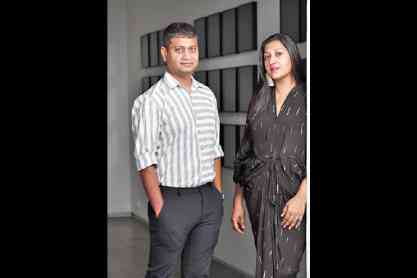While Calcutta was busy prepping for the grand Durga Puja celebrations last month, Experimenter art gallery won global recognition for Calcutta and India. The gallery which was founded by Priyanka and Prateek Raja in 2009, won the prestigious Frieze London Stand Prize for the best gallery presentation. We caught up with Priyanka and Prateek to learn more about the prize that’s close to their heart.
Congratulations on the big win! What does this win mean to you and your team?
Frieze is one of the most important art fairs and one of the most prestigious platforms for galleries worldwide. There are hundreds of entries and if the jury found that Experimenter’s stand was impressive then it’s a matter of great pride for us. We are amongst colleagues we respect and admire deeply and I feel it’s a great honour because people put their best foot forward when they are at a platform like this.
Also, Frieze has a special place in our hearts as this was the first art fair we ever did in 2010; we participated for the first time when we were a one-year-old gallery and we were the only ones from Calcutta to get through. Getting through Frieze itself is a great challenge as there are thousands of applications and only a few are selected. So all in all it feels great. We architecturally built the booth that had a sense of navigation. I think several elements helped us in building a strong presence.
Tell us about the stand and what was the idea behind it.
This time the title was How to Start a Fire, which was a comment by late Reba Hore, the lead artist, who had said it to Navin Kishore and that had sparked a series of thoughts about how to start a fire. It could be a personal one or a political or larger commentary. So, we selected these eight diverse artists to be a part of the stand at Frieze London.

Prateek and Priyanka Raja Pictures courtesy Experimenter and Vivienne Sark
While Ayesha Sultana (India) explores spatial encounters and movement in a measurement of space between things, Biraaj Dodiya (India) and Radhika Khimji (Oman) unravel practices rooted in navigating landscapes, uncertainties and distance through acts of abrasion or resistance. Afrah Shafiq (India) and Bani Abidi (Pakistan) explore dynamics of power through a diversity of research modes and devices, rupturing existing narratives, and creating subversive, speculative new ways of looking at the familiar. Bhasha Chakrabarti (USA) offers a deeply personal lens into the genre of still life and explores the act of painting as memorialising intimacies and relationships. Juxtaposed alongside is the practice of the late Reba Hore (India), whose paintings emanate fervent, frantic lines of colours making form, figure and landscape indiscernible while revealing a singular gaze from the interiority of an entangled knot of experiences. Lastly, in Sakshi Gupta’s (India) sculptural works, emerging from continued engagement with found objects and industrial scrap, the crosses between banal inanimate objects and animal-human world arise from an acute need to blur these rigid confines and experience the self in a larger context, while re-evaluating notions of transience and resilience.
Where from here?
We are already doing what we were doing. The next thing is our focus on Experimenter Curators' Hub which will kick off later this month. Apart from that, we will have interesting solo and collaborative shows in our Mumbai and Calcutta galleries.
